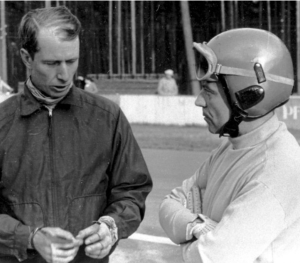Sixty years ago, when the calendar flipped to begin 1955, the American Automobile Association began its 54th season as the major sanctioning body for auto racing in the United States. AAA ran racing with an iron hand and drivers with aspirations of competing at the Indianapolis 500 were forced to work their way up the AAA sanctioned ladder of midget and sprint car events before receiving authorization from AAA officials to compete in the most prestigious race in the country.
But the ’55 campaign turned dark early in the year when on March 20 Larry Crockett was fatally injured in a AAA sprint car event on the dirt mile at Langhorne, Pennsylvania. The tragedy was compounded when, during a Crockett Memorial race run at Langhorne on May 1, Mike Nazaruk was in the lead when he made contact with the outside rail and suffered fatal injuries during the vicious series of flips that ensued.
When the elite of open wheel racing convened at Indianapolis later that May, veteran driver Manny Ayulo was fatally injured during a practice crash on the 16th. With many competitors believing bad things come in threes, there was hope to finally get some positive press for auto racing’s jewel on the schedule, the Indy 500. These hopes were dashed when, during the race, two-time and defending Indianapolis champion Bill Vukovich was killed pursuing his third straight Indy win.
While the Vukovich fatality at Indy was big news in the United States, two events in Europe also shocked the racing world. On May 26th, Alberto Ascari, the 1952 and 1953 World Champion as a Suderia Ferrari driver, crashed to his death in practice for the Grand Prix at Monza, Italy. Ascari had qualified a Ferrari for Indy in 1952 and was well-known and well-liked in the States.

1953 Formula One World Championship.. Alberto Ascari (I).. Scuderia Ferrari.
Following the loss of Ascari, the 23rd running of the Grand Prix d’Endurance, known better in the US as the 24 Hours of LeMans, made worldwide headlines in June. Just 35 laps into the event, race leader Mike Hawthorn received a late signal to pit. He made a quick right to enter pit lane, assisted by the new disc brakes on his Jaguar D-type. Lance Macklin, driving a slower Austin-Healey 100 that Hawthorn had just passed, swerved to the left to avoid a collision because he couldn’t match the braking power of the Jaguar. The maneuver put the Healey in the path of Pierre Levegh’s #20 Mercedes-Benz 300 SLR. Levegh’s car made contact with Macklin’s left rear and catapulted into the main grandstand at 150 mph.
It was racing’s most gruesome accident. Front end suspension parts, sheet metal, and even the engine separated from the chassis and knifed through the crowd. The fuel cell burst into flames and ignited the remains of the car’s magnesium alloy body causing a fire in the grandstand, which spread when firefighters attempted to use water to put out the flames. In the end, Levegh and 83 spectators were pronounced dead at the scene, with upward of 120 spectators injured. The world’s newspapers trumpeted the tragic details.
The dark year of 1955 continued when AAA sprint car driver Jerry Hoyt was fatally injured on the Oklahoma City half mile dirt track on July 10. Hoyt was the Indy pole winner that year and had married only two weeks before his fatal crash.
After several months of horrific press for the sport of auto racing, and two days after the loss of Hoyt, US Senator Richard Neuberger, Democrat of Oregon, rose before his colleagues on the floor of the senate on July 12, 1955. Neuberger said, “Mr. President, I think the time has come to forbid automobile racing and similar carnages in the United States. I doubt if there is as much bloodshed in Spanish bullrings as today is occurring on automobile race tracks in this country. Now, even women racing drivers are getting killed in fiery and dreadful wrecks… I believe the time has come for the United States to be a civilized nation and stop carnage on racetracks. The deaths on our highways are sad and tragic, but at least they are not purposely staged for profit and for the delight of thousands of screeching spectators.”

John Fitch and Pierre Levegh
As the national sanctioning body for professional racing the country, AAA was thrust into the middle of the controversy. And so on August 3, 1955, AAA President Andrew J. Sordoni released this statement: “Upon completion of the schedule of events already undertaken for the year 1955, the AAA will ‘disassociate’ itself completely from all types of automobile racing in the United States.”
After the initial shock of the AAA decision, many in racing circles came to see this development as an opportunity, rather than a problem. Indianapolis Motor Speedway owner Anton “Tony” Hulman called a meeting on August 10th in Indianapolis for all racing personnel affected by the AAA withdrawal. 216 men from all corners of the country attended. From that meeting grew USAC, the United States Auto Club, which would take over as racing’s sanctioning body beginning in 1956.
Over the final four months of 1955, while the organization and structure of USAC were being developed, America’s professional racers completed the 1955 AAA schedule. Only the death of popular Jack McGrath during the running of the Bobby Ball Memorial championship car race at the Arizona State Fairgrounds in Phoenix on November 6th marred the rest of the year. The new sanctioning body then presented a full season of racing in 1956.
Today, both AAA and USAC remain in operation, sixty years after the dark days of 1955. AAA catering to private automobile owners, and USAC, despite no longer being associated with the Indianapolis 500, still sanctioning races.
CarShowSafari.com is grateful for the resources of the Eastern Auto Racing Historical Society in the preparation of this article.

